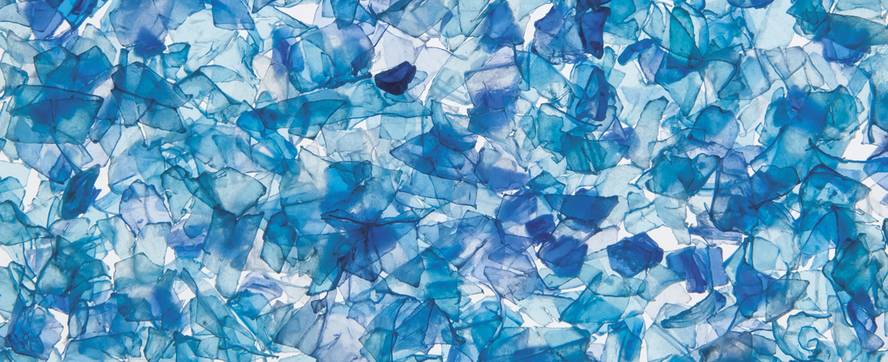Microplastics and health

Ekologistak Martxan taldeko kidea eta EHUko Bilboko Ingeniaritza Eskolako irakaslea
Plastic is one of the best inventions in our society. Light, flexible and very economical. In this way, it is the most suitable material for both creation and collection of everything. We have generated billions of tons of plastic, 75% of which have become waste. Therefore, the benefits of plastic have become a problem to turn plastic waste management into one of the biggest problems in our society. They have already been included in all ecosystems and it is under discussion what risks may pose their introduction at the cellular level. Meanwhile, our consumption model does not seem easily modifiable. What is the solution?
To discuss plastics and their problems, Elhuyar organized an open debate at the San Telmo Museum. The following pages show the views of experts at the roundtable and the public's reflections can be found on the Zientziakide project website. The experts are:
Joana Larreta Astola, AZTI oceanographer and doctor in Analytical Chemistry. Investigates in the Environmental Management Group of Seas and Coasts.
Joserra Otegi Olaso, professor at the Bilbao School of Engineering at UPV and member of Ekologistak Martxan. Within the group he works in the Waste Commission.
Miren Cajaraville Bereziartua, Professor of Cell Biology at the UPV and Head of the Research Group of the Basque Government in Cell Biology in Environmental Toxicology.
“Addressing marine waste management”
Related information
Oceanographer and Doctor of Analytical Chemistry (AZTI)
Today, society is very concerned, among other things, about the presence of microplastics in the environment, especially its presence in the sea and its influence on marine animals and human health. This is a fashion issue that is having a great impact on the media, even though for decades plastics are scattered around the environment. Researchers have been working on this topic for years, and many studies are focused on providing answers and solutions to issues raised from society and institutions. However, more research is needed.
Facts about the Basque Country
We know that plastics are present in all seas and in large quantities. The LIFE LEMA project (https://www.lifelema.eu/es/) has been in charge, among other things, of quantifying the garbage that accumulates on the Basque coast. To do this, the garbage that passes through the rivers has been monitored, the ships that collect the garbage intelligently have been used and mathematical models have been developed to make forecasts. Moreover, sewage containment systems have been analyzed and alert applications have been developed for administrations.
The results have shown that garbage accumulates in rows in coastal waters, which have an average length of 1 km and accumulate between 60 and 92 kg, exceeding in spring summer. Keep in mind that in spring and summer boats circulate that “fish” large amounts of garbage, which can derive to some extent in a smaller amount in summer. In addition, the Gipuzkoan coast is less concentrated than in the north, due to the influence of the Aturri River and the currents that are generated on the north coast. As for microplastics, the study on the aqueous surface showed that: They accumulate between 0.7 and 15.300 g/km2 and on the north coast 5 times more than in Gipuzkoa.
Where does plastic come from?
The data show the need to address marine waste management once and for all. In fact, once the weight analysis of the origin of plastics has been carried out, it has been proven that 50% comes from actions that are carried out in the sea (fishing, maritime transport, tourism…) and that the origin of everything else can not be well known, since it can come from the land or be marine.
The most common products that can be found on the coastal marine surface are the small pieces of plastic and the ropes, nets and nozzles used for fishing. In a smaller percentage, plastic products of unidentifiable origin, food containers, bottles and caps, bags of snacks and sticks.
The question of additives
In the LIFE LEMA we have analyzed what is on the surface of the sea, but we know that in the seabed, sediments, sands and marine also appear plastics and microplastics. Its influence is clear, especially physical, but its impact on chemical pollution requires more studies. It is necessary to analyze the chemical effect of additives that give plastics the appearance, shape and hardness for different uses.
To be able to compare what appears in other places it is necessary to make the work similar, since there is no common procedure, neither to perform sampling, nor to perform analysis of the samples taken, nor to reflect the results. The European Marine Strategy describes what needs to be analyzed, but does not indicate which methodology to use and at European level there are difficulties when comparing data. From a scientific point of view a solution is being given to this vacuum, but plastics and microplastics are a challenge and have many lines of research for the high number of questions. What is clear is that, as plastics are polluting, clear and rigorous regulations are needed around them.
“Plastics: recycling is not the solution”
Related information
Member of Ekologistak Martxan and professor at the Bilbao School of Engineering at UPV
Currently we launched 22,000 tons of plastic a day into the sea. To make a comparison, the Prestige disaster emitted 60,000 tons of fuel in 2002, an amount we issued in two or three days.
Some of the microplastics are intentionally produced as raw material for the production of plastic products. But most are a consequence of the deterioration of plastic parts. These plastic parts end up in inland waters or oceans and degrade. They go up the trophic chain until they reach the human being.
It is estimated that since we started producing plastic we have generated 8.3 billion tons of plastic, of which 6.3 billion tons have become waste. That is, we have converted most of what is generated into waste. But why does plastic end up in the waste system? The producers do not take care of the waste, passing the plastic ownership of the producer to the consumer. Finally, the user expels it and becomes a disinterested responsibility of society.
Sugar industry
The most commonly used plastic waste is food packaging, bottles and bags. In fact, processed foods are the ones that use the most plastic for their collection, and the relationship between both is curious: the high salt and sugar content of preprocessed foods makes that, in addition to being unrecommended by nutritionists, its packaging becomes a threat to human health. The sugar and plastic industries are in close relationship.
On the other hand, plastic “travels well”. Being cheap and good to collect and transport anything, it generates a social problem: it drives industrial production away from the consumer.
From the cost point of view, however, not the entire plastic lifecycle is correctly calculated. It should collect the cost of recovery after use, as advocated by Producer Wide Responsibility programs. If this were done, it would be less profitable.
Recycling reduces awareness
Recycling is not the solution. Most of the plastic cannot be recycled, although the large bottlers are committed to talking about the recyclability of the plastic, being profitable a very small percentage of the recyclable. In addition, only a small part of this small section is recovered. And that has no way of changing.
Depositing empty bottles in the yellow container gives the feeling of having fulfilled our share of responsibility, but it really minimizes awareness of the excessive use of natural resources.
If we are committed to making plastic the only solution to our everyday problems and use it constantly to transport water, dress and protect our food… we are also betting on finding plastic in our food, in our water and in the air we breathe.
Making plastic production difficult
The World Health Organization believes that more research is needed on chemical contamination of plastics. However, it insists on the need to curb the increase in plastic pollution that is occurring globally. And recommends: “Measures should be taken to better manage plastics and, as far as possible, to reduce their use. In fact, although exposure to microplastics in drinking water carries a low risk to health, these actions can bring other benefits to the environment and human well-being.”
Excess consumption is at the base of overproduction of food and clothing, as well as the plastics that accompany them. It makes us irresponsible for the consequences of our consumption habits. But this also creates the disruption of local communities and increases social injustices.
Organizations must bet on closer consumption in time and space. And that producers are really responsible for their waste. I think plastic production must be complicated. And rethink waste management systems.
“Micro and nanoplastics can act as Trojan horses”
Look at Cajaraville Bereziartua
Professor of Cell Biology (UPV)
The large production of plastics in recent decades has completely exceeded our plastic waste management capacity. The conclusion is well known: plastic waste has been deposited in terrestrial and aquatic media around the world. Between 4.8 and 12.7 million tons of plastic come annually to the seas and oceans of the world, becoming giant landfills. We have all seen in the media spectacular and moving images of turtles or fish stuck with fishing nets or other large plastics. However, unfortunately, faced with these direct physical effects of large plastics, small, less spectacular plastics have to worry much more.
Micro and nanoscale
Microplastics are plastic materials less than 5 mm, among which those under 100 nm are called nanoplastics. Most micro-plastics and nanoplastics are formed by breakage of larger plastics in the medium. Others, however, occur directly to this size. Due to their small size, they can be ingested by diverse organisms, able to penetrate the cells and cause damage. This capacity depends on the type of polymer, size, shape, etc.
Microplastics, Trojan horse
As the trophic chains rise, the biomagnification of microplastics and nanoplastics occurs, which have already appeared in humans. Moreover, the high surface/volume ratio and hydrophobicity of microplastics and nanoplastics allow adsorbing persistent organic pollutants in the medium and increase their availability for organisms. Therefore, they transport persistent organic pollutants acting as Trojan horses. They can also be pathogenic transporters. In addition to the main polymer, additives such as flame retardant products, plasticizers, colouring agents, ultraviolet light stabilizers and antioxidants may appear in the composition of plastics. Some of them are hazardous compounds that can be released into the environment. Some people can act as endocrine disruptors, which poses an additional risk to the health of ecosystems and people.
How to track microplastics?
Until recently, the effects of microplastics and nanoplastics on organisms have been mainly investigated through laboratory experiments using commercial spherical microplastics and nanoplastics. One of the challenges we face is to understand the effects of microplastics and nanoplastics present in the environment, not only of spherical particles, but also of fibers and other forms. It is imperative to analyze the ability of these “real” media plastics to adsorb and release hazardous chemical compounds to understand the damage they can cause in the medium. On the other hand, although progress has been made in microplastic monitoring technology in the environment and in organisms, another important challenge is to be able to monitor the nanoplastics present in the environment and in organisms, including humans.
In general, it is inevitable to intensify efforts to reduce plastic pollution, in order to avoid the environmental, social and economic impacts of this pollution and, consequently, our well-being. This will require drastically reducing the production of sustainable plastics and improving the effective and longer-term reuse strategies of plastic waste, moving towards a circular economy of plastics. The area of biodegradable plastics should also be promoted to the extent that they have a lower risk to the environment. But in order to solve the problem of plastic pollution, it will be necessary to carry out profound social and economic changes at all levels, from local to global.








